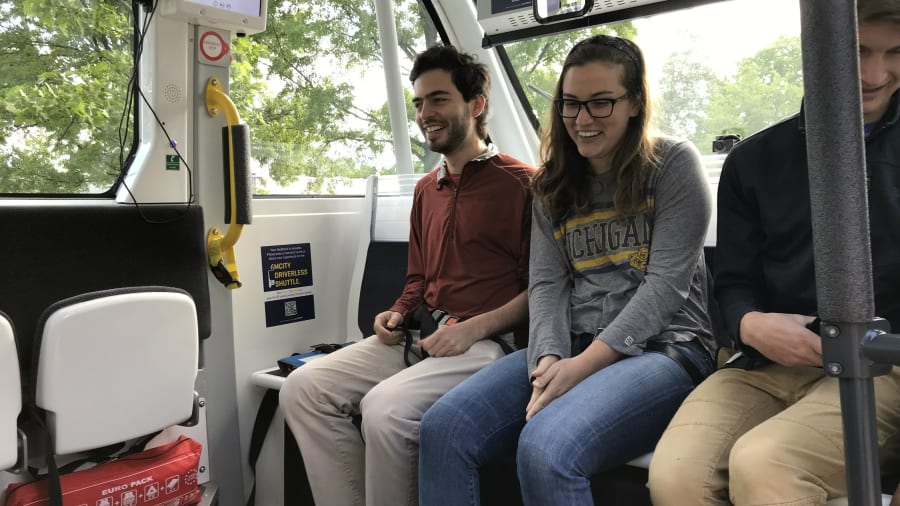ANN ARBOR – Riders and nonriders of the driverless shuttles on University of Michigan’s North Campus had a high level of trust in the vehicles, according to a report my Mcity.
The project, which was completed in 2019, was the first project in the U.S. to focus primarily on data collection and consumer acceptance of autonomous shuttles.
Recommended Videos
A consumer survey conducted by U-M’s public-private vehicle research center in collaboration with J.D. Power revealed that 86 percent of riders and 66 percent of nonriders said they trusted the technology.
Built by French firm Navya, the all-electric shuttles were fully automated and could carry 11 passengers. A trained conductor would ride in each shuttle for safety and troubleshooting purposes. Students, faculty and staff rode the shuttles on a one-mile loop around the North Campus Research Complex, which has distant parking lots.
One of the shuttles was donated to The Henry Ford in Dearborn, the museum announced on Thursday.
According to a white paper published on Thursday, no major incidents or injuries were recorded during the study.
The shuttles launched in 2018 just as two fatal crashes involving partially autonomous cars in Arizona and California made national headlines. According to separate surveys by AAA and J.D. Power published earlier this year, consumer sentiment remained weak across the nation.
“That the Mcity Driverless Shuttle research project resulted in high levels of consumer satisfaction and trust among riders, in spite of declining satisfaction with AVs nationally, underscores the importance of robust preparation and oversight to ensure a safe deployment that will build consumer confidence,” Huei Peng, director of Mcity said in a statement. “Without that, we will never achieve the full potential of driverless vehicles to improve traffic safety, cut fuel consumption and increase mobility for those with limited transportation options.”
Since the program launched, other driverless shuttle services have started to operate across the country, including Waymo and Ann Arbor-based May Mobility.

✉ Like what you’re reading? Sign up for our email newsletter here!
According to the white paper, other key findings include:
- 97% of survey respondents were aware that the shuttle was fully automated. The majority rode the shuttle one time, and it replaced mostly pedestrian transportation (47%) with most rides taken during afternoon hours (63%).
- Interest in AVs and general curiosity were primary factors for riders. Removing the hassle of finding parking and improving current mobility methods were predicted to be more relevant to respondents, but, in fact, were negligible.
- Regardless of their feedback for improving the shuttle, riders were very satisfied with their driverless shuttle experience. On a scale from 1-10 with 10 being “truly exceptional,” riders rated their experience a 7.87 (mean), and 75% said they would be willing to ride the driverless shuttle again.
- A vast majority of riders, 86%, stated post-ride that they trusted the Mcity Driverless Shuttle; as did 67% of nonriders surveyed, including pedestrians, bicyclists and other vehicle drivers.
- Riders' and nonriders' thoughts regarding personal self-driving vehicles were positively impacted by the shuttle, generating more interest in the technology as a result of riding or seeing it in operation.
Mcity’s takeaways from the project and how they can be applied to future shuttle deployments include:
- Provide a practical transportation alternative that happens to be automated, not the other way around.
- Consider speed, number of stops and convenience to riders. Slow speeds and limited on-route stops did not make the Mcity Driverless Shuttle a practical alternative to riders' daily transportation challenges.
- Establish robust safety protocols, operator training and communication.
- Support the service with outreach and education to key audiences to engage the community and encourage ridership.
“Researching consumer interaction with the Mcity Driverless Shuttle emphasized the critical importance that experience brings to building trust with automated vehicle technology,” Kristin Kolodge, executive director of driver interaction and human machine interface at J.D. Power said in a statement. “The skepticism and hesitancy consumers felt prior to riding the shuttle was diminished by many through a positive experience.”



